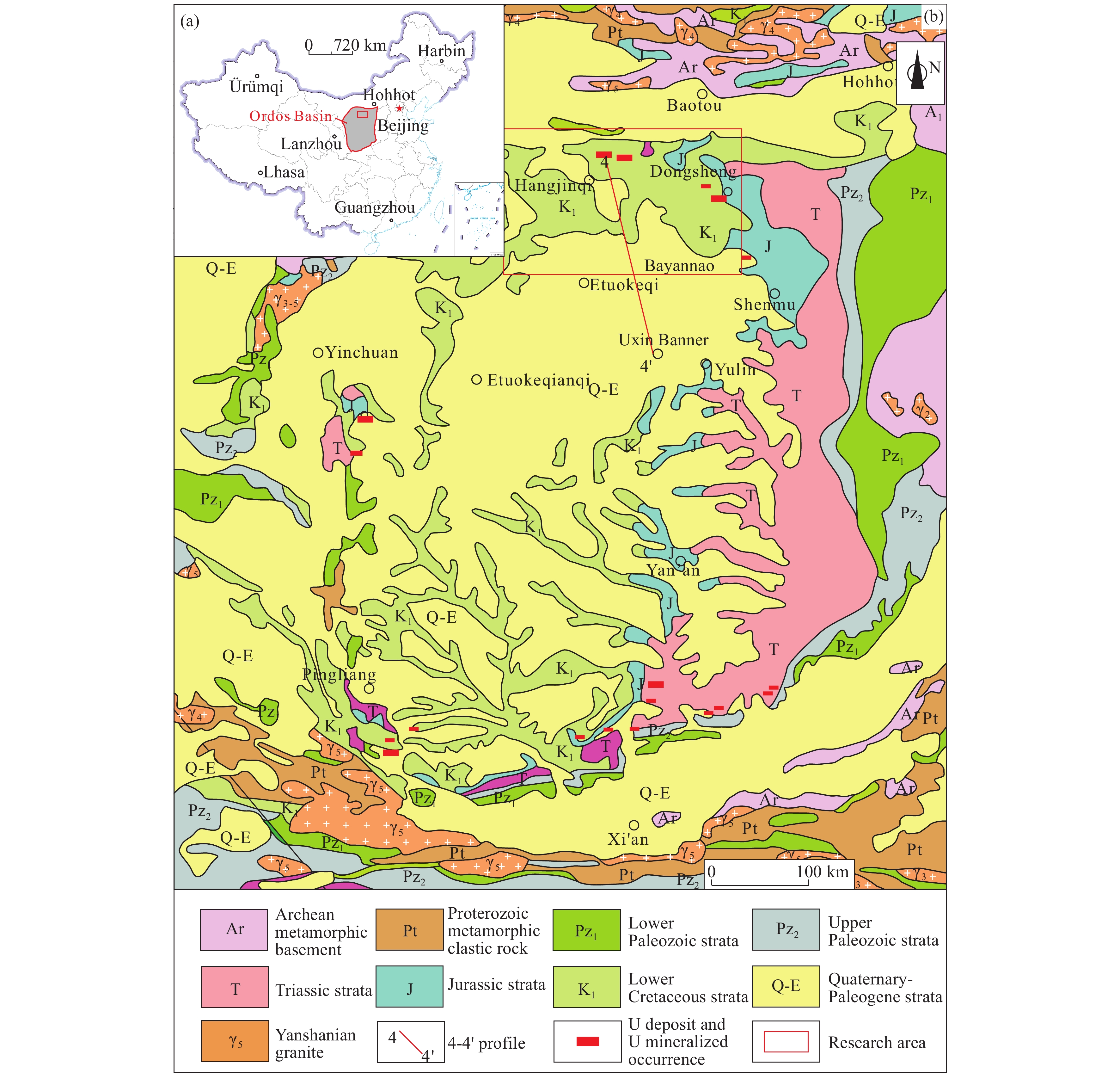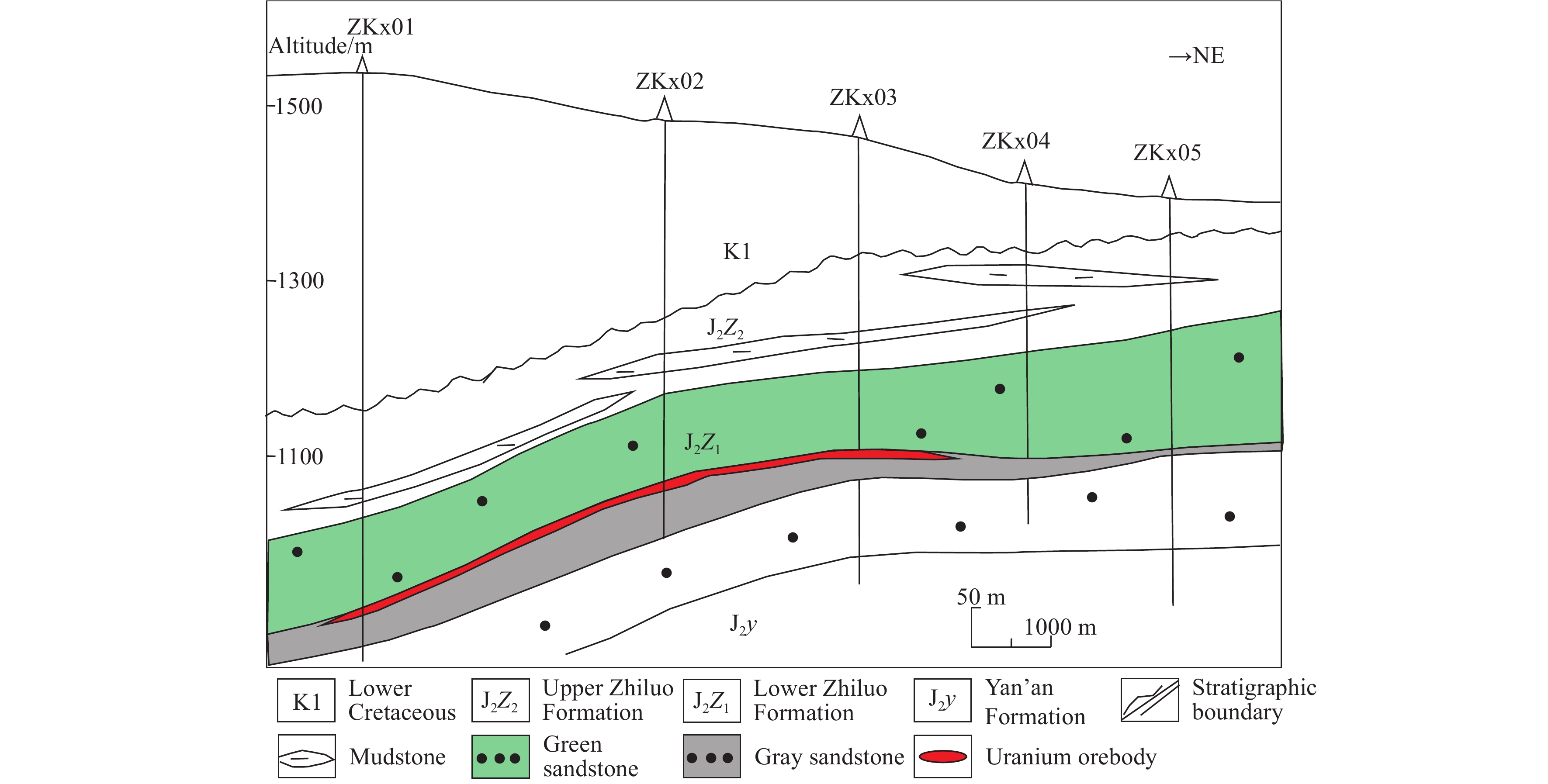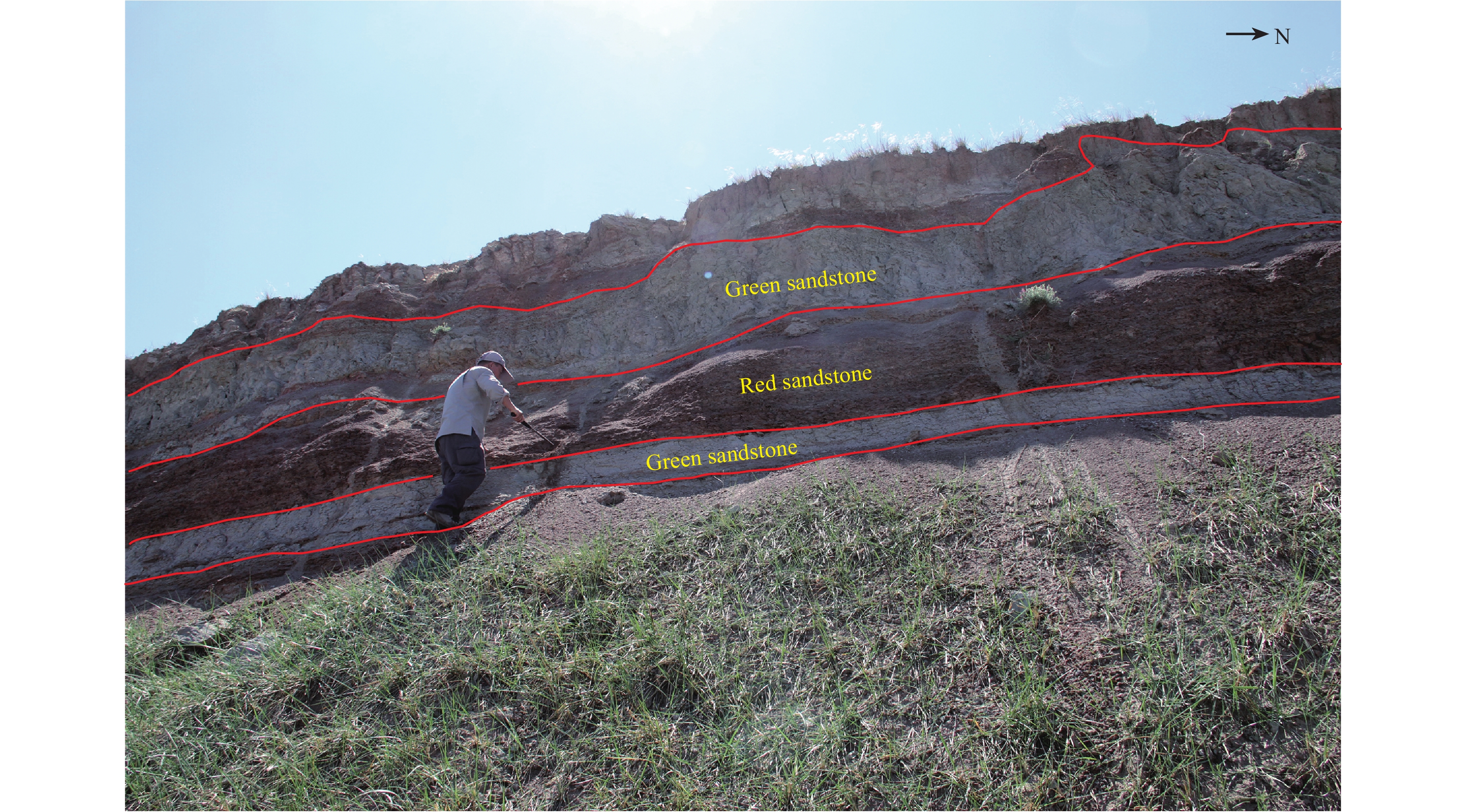| Citation: | Ruo-shi Jin, Xiao-xi Feng, Xue-ming Teng, Feng-jun Nie, Hai-yang Cao, Hui-qun Hou, Hong-xu Liu, Pei-sen Miao, Hua-lei Zhao, Lu-lu Chen, Qiang Zhu, Xiao-xi Zhou, 2020. Genesis of green sandstone/mudstone from Middle Jurassic Zhiluo Formation in the Dongsheng Uranium Orefield, Ordos Basin and its enlightenment for uranium mineralization, China Geology, 3, 52-66. doi: 10.31035/cg2020002 |
Genesis of green sandstone/mudstone from Middle Jurassic Zhiluo Formation in the Dongsheng Uranium Orefield, Ordos Basin and its enlightenment for uranium mineralization
-
Abstract
The middle Jurassic Zhiluo Formation in the Dongsheng is comprised of a big set of green sandstone/mudstone with most of uranium orebodies occurring in close proximity to its footwall. By synthesizing field observations, region analysis, data collected from previous coal and uranium borehole, a regional north-south geological profile across the entire orefield is conducted. Experiments on sandstone/mudstone including rock mineral identification, clastic micromorphology and element geochemistry were carried out. Information from the geological profile indicates that green sandstone/mudstone is widely present in a stable horizon with clear boundaries to the country rock. Microscopic observations and geochemical data on sandstone/mudstone exhibit similar mineral composition with almost identical slightly flat, minor Eu enriched, Ce depleted chondrite-normalized REE patterns. Furthermore, the green clay membrane of the clasts has a complex composition containing chlorite/smectite, green smectite, chlorite, and green kaolinite, with elements including Fe, Mg, Si, and Al. These above results indicate that the green sandstone/mudstone underwent resemble sedimentary diagenetic processes as the country rock without transformation by large-scale regional fluid, while the existence of Fe2+-rich membrane is the main factor to the green sandstone/mudstone. Further concentration of the pre-enrichment uranium during diagenetic process led to the final formation for uranium deposits. The above studies are conducive to enrich the metallogenic mechanism of sandstone type uranium deposits and could provide certain reference for uranium exploration and deployment.
-

-
References
[1] Abdelnasser A, Kumral M, Zoheir B, Karaman M, Weihed P. 2018. REE geochemical characteristics and satellite-based mapping of hydrothermal alteration in Atud gold deposit, Egypt. Journal of African Earth Sciences, 1, 13–26. [2] Boles A, Mulch A, van der Pluijma B. 2018. Near-surface clay authigenesis in exhumed fault rock of the Alpine Fault Zone (New Zealand); O-H-Ar isotopic, XRD and chemical analysis of illite and chlorite. Journal of Structural Geology, 111, 27–41. doi: 10.1016/j.jsg.2018.03.008 [3] Chen Y, Feng XX, Chen LL, Jin RS, Miao PS, Sima XZ, Miao AS, Tang C, Wang G, Liu ZR. 2017. An analysis of U-Pb dating of detrital zircons and modes of occurrence of uranium minerals in the Zhiluo Formation of northeastern Ordos Basin and their indication to uranium sources. Geology in China, 44, 1238–1247 (in Chinese with English abstract). [4] Ding WL. 2003. Geochemical character of green-color alteration and its prospecting significance. Uranium Geology, 19, 277–282 (in Chinese with English abstract). [5] Fan AP, Liu YQ, Yang RC, Zhang FX. 2006. Diagenesis and paleo-fluid migration events in the Zhiluo formation in Dongshen area. Acta Geologica Sinica, 80, 694–700 (in Chinese with English abstract). [6] Fan AP, Liu YQ, Yang RC, Feng Q, Zhang FX, Han ZZ. 2007. Research on diagenesis of the sandstone-type uranium deposits in Dongshen area, Ordos basin. Science in China Series D: Earth Sciences, 50, 195–202. doi: 10.1007/s11430-007-6011-4 [7] Feng XX, Jin RS, Miao PS, Sima XZ, Li JG, Zhao HL, Chen Y, Chen LL, Tang C, Ao C, Wang XH. 2017. Uranium source analysis and its geological significance to uranium metallogenic evolution in Dongsheng Uranium Orefield. Geology in China, 44, 608–619 (in Chinese with English abstract). [8] Gong YM, Shi XY. 2014. Thinking on time, sedimentation and stratigraphy. Science Frontiers, 21, 27–35 (in Chinese with English abstract). [9] Hall SM, Mihalasky MJ, Tureckl KR, Hammarstrom JM, Hannon MT. 2017. Genetic and grade and tonnage models for sandstone-hosted roll-type uranium deposits, Texas Coastal Plain, USA. Ore Geology Reviews, 80, 716–753. doi: 10.1016/j.oregeorev.2016.06.013 [10] Haskin LA, Wildeman TR, Haskin MA. 1968. An accurate procedure for the determination of the rare earths by neutron activation. Journal of Radioanalytical Chemistry, 1, 337–348. doi: 10.1007/BF02513689 [11] Jaireth S, Roach IC, Bastrakov E. 2015. Basin-related uranium mineral systems in Australia: A review of critical features. Ore Geology Reviews, 76, 360–394. [12] Jiao YQ, Wu LQ, Peng YB, Rong H, Ji DM, Miao AS, Li HL. 2015. Sedimentary-tectonic setting of the deposition-type uranium deposits forming in the Paleo-Asian tectonic domain, North China. Earth Science Frontiers, 22, 189–205 (in Chinese with English abstract). [13] Jin RS, Cheng YH, Li JG, Sima XZ, Miao PS, Wang, SY, Ao C, Li HL, Li YF, Zhang TF. 2017. Late Mesozoic continental basin “Red and Black beds” coupling formation constraints on the sandstone uranium mineralization in northern. Geology in China, 44, 205–223 (in Chinese with English abstract). [14] Kacmaz H, Burns PC. 2017. Uranyl phosphates and associated minerals in the Koprubasi (Manisa) uranium deposit, Turkey. Ore Geology Reviews, 84, 102–115. doi: 10.1016/j.oregeorev.2017.01.001 [15] Kong ZG, Wu Y, Zhang F, Zhang Q, Meng XY. 2018. Sources of ore-forming material of typical Pb-Zn deposits in the Sichuan-Yunan-Guizhou metallogenic province: Constraints from the S-Pb isotopic compositions. Earth Science Frontiers (China university of Geosciences (Beijing); Peking university), 25(1), 125–137. [16] Kumar AS, Venkatesh AS, Kumar P, Rai AK, Parihar PS. 2017. Geochemistry of archean radioactive quartz pebble conglomerates and quartzites from western margin of Singhbhum-Orissa Craton, eastern India: Implications on paleo-weathering, provenance and tectonic setting. Ore Geology Reviews, 89, 390–406. doi: 10.1016/j.oregeorev.2017.06.014 [17] Lecomte A, Cathelineau M, Michels R, Peiffert C, Brouand M. 2017. Uranium mineralization in the Alum Shale Formation (Sweden): Evolution of a U-rich marine black shale from sedimentation to metamorphism. Ore Geology Reviews, 88, 71–98. doi: 10.1016/j.oregeorev.2017.04.021 [18] Li RX, Duan LZ, Chen BY, Zhang SN. 2011. Alteration and metallogeny on the oxic-acid /anoxic-alkali interface of the Dongsheng uranium deposit in Northern Ordos Basin. Geotectonica et Metallogenia, 35, 525–532 (in Chinese with English abstract). [19] Li RX, Li YZ. 2011. The geologic features of mineralization at the Dongsheng uranium deposit in the northern Ordos Basin (Central China). Russian Geology and Geophysics, 52, 593–602. doi: 10.1016/j.rgg.2011.05.003 [20] Li SJ, Zhang R, Wang QC. 2006. Implications of the color of sediments and clay minerals for tertiary climatic changes of Kuqa Depression. Acta Sedimentologica. Sinica, 24, 521–520 (in Chinese with English abstract). [21] Li XD, Yi C, Gao HW, Chen XL, Zhang K, Wang MT. 2016. Study on formation mechanism of epigenetic altered zone in Zhiluo Formation, Northeastern Ordos Basin, North China. Geoscience, 30, 739–747 (in Chinese with English abstract). [22] Li ZH, Dong SW, Feng SB, Qu HJ. 2015. Sedimentary response to middle–late Jurassic tectonic events in the Ordos Basin. Acta Geoscietica Sinica, 36, 22–30 (in Chinese with English abstract). [23] Li ZY, Fang XH, Chen AP, Ou GX, Sun Y, Zhang K, Xia YL, Zhou WB, Chen FZ, Li MG, Liu ZH, Jiao YQ. 2009. Superposition metallogenic model of sandstone-type uranium deposit in the Northeastern Ordos basin. Uranium Geology, 25, 65–71 (in Chinese with English abstract). [24] Li ZY, Fang XH, Chen AP, Ou GX, Xiao XJ, Sun Y, Liu CY, Wang Y. 2007. The cause of formation of gray green sandstone in sandstone type uranium deposits in northern Ordos Basin. Science in China Series D: Earth Sciences, 37(supplement), 139–146. [25] Liu WS, Zhao XQ, Shi QP, Zhang ZN. 2017. Research on relationship of oil-gas and sandstone-type uranium mineralization of northern China. Geolology in China, 44, 279–287 (in Chinese with English abstract). [26] Long YZ, Chi GX, Liu JP, Jin ZG, T G. 2017. Trace and rare earth elements constraints on the sources of the Yunfeng paleo-karstic bauxite deposit in the Xiuwen-Qingzhen area, Guizhou, China. Ore Geology Reviews, 91, 404–418. doi: 10.1016/j.oregeorev.2017.09.014 [27] Miao AS, Lu Q, Liu HF, Xiao P. 2009. Occurrence and formation of coffinite in ancient interlayer oxidizing zone of sandstone type U-deposit in Ordos Basin. Geological Science and Technology Information, 28, 51–57 (in Chinese with English abstract). [28] Miao AS, Jiao YQ, Chang BC, Wu LQ, Rong H, Liu ZB. 2010. Detailed investigation of the paleo-interlayer-oxidation zone of Dongsheng uranium deposit in northeastern Ordos Basin. Geological Science and Technology Information, 29, 55–61 (in Chinese with English abstract). [29] Min MZ, Wang NC, Bian LZ, Zhang FS, Peng XJ, Wang JP, Li PF, Yi L, Zhang GH. 2003. Biomineralization in the interlayer oxidizing zone of sandstone type U-deposit. Progress in Natural Science, 13, 164–168 (in Chinese with English abstract). [30] Peng YB, Chen AP, Fang XH, Ou GX, Xie QL. 2007. Relationship between hydrocarbon-containing fluid and metallogenesis in Dongshen sandstone-type uranium deposit. Geochimica, 36, 267–274 (in Chinese with English abstract). [31] Quan JP, Fan TL, Xu GZ, Li WH, Chen HB. 2007. Effects of hydrocarbon migration on sandstone-type uranium mineralization in basins of northern China. Geology in China, 34(3), 470–477 (in Chinese with English abstract). [32] Rahiminejad AH, Zand-Moghadam H. 2018. Synsedimentary formation of ooidal ironstone: An example from the Jurassic deposits of SE central Iran. Ore Geology Reviews, 95, 238–257. doi: 10.1016/j.oregeorev.2018.02.028 [33] Shao HB, Yang SY, Humphris S, Cai D, Cai F, Li JT, Li Q. 2017. The origin of hydrothermal chlorite-and anhydrite-rich sediments in the middle Okinawa Trough, East China Sea. Chemical Geology, 465, 35–51. doi: 10.1016/j.chemgeo.2017.05.020 [34] Sun LX, Zhang Y, Zhang TF, Cheng YH, Li YF, Ma HL, Yang C, Guo JC, Lu C, Zhou XG. 2017. Jurassic sporopollen of Yan’an Formation and Zhiluo Formation in the northeastern Ordos Basin, Inner Mongolia, and its paleoclimatic significance. Earth Science Frontiers, 24, 32–51 (in Chinese with English abstract). [35] Tang C, Sima XZ, Zhu Q, Feng XX, Chen Y, Chen LL, Liu XX. 2016. Carbon and oxygen isotopic composition and uranium mineralization significance of calcite to Zhiluo Formation uranium-bearing sandstone in Dongsheng area. Geological Journal of China Universities, 22, 698–706 (in Chinese with English abstract). [36] Vasyukova OV, Williams-Jones AE. 2018. Direct measurement of metal concentrations in fluid inclusions, a tale of hydrothermal alteration and REE ore formation from Strange Lake, Canada. Chemical Geology, 483, 385–396. doi: 10.1016/j.chemgeo.2018.03.003 [37] Wang M, Luo JL, Li M, Bai XJ, Cheng C, Yan LW. 2013. Provenance and tectonic setting of sandstone-type uranium deposit in Dongsheng area, Ordos basin: Evidence from U-Pb age and Hf isotopes of detrital zircons. Acta Petrologica Sinica, 29, 2746–2758 (in Chinese with English abstract). [38] Wu BL, Wei AJ, Hu L, Song ZS, Zhang BH, Wang HT, Wang D, Cun XN, Sun L, Luo JJ. 2014. The Hydrocarbon Dissipation and Its Effect of Diagenetic and Mineralization: Progress, Understanding and Outlook. Geological Review, 60, 1199–1211 (in Chinese with English abstract). [39] Xia F, Meng H, Nie FJ, Yan ZB, Zhang CY, Li MG. 2016. Characteristics of chlorite from the Nalinggou uranium deposit in the Ordos Basin and its geological significance. Acta Geologica Sinica, 90, 3473–3482 (in Chinese with English abstract). [40] Xia YL, Liu HB. 2005. Pre-enrichment and metallogeny of uranium in Zhiluo formation sand bodies of Dongsheng area, Ordos Basin. World science Geoscience, 22(4), 187–191 (in Chinese with English abstract). [41] Xiang WD, Fang XH, Li TG, Chen XL, Pang YQ, Cheng HH. 2006. Metallogenic characteristics and model of Dongsheng uranium deposit in Ordos basin, North China. Uranium Geology, 22(5), 257–265 (in Chinese with English abstract). [42] Xiao XJ, 2004. The mineralization geochemistry of the low temperature fluid on the Dongsheng sandstone type uranium deposit. Beijing: Doctoral dissertation, CNNC Beijing Research Institute of Uranium Geology, 1–104 (in Chinese). [43] Yang XY, Ling MX, Lai XD. 2009. Metallogenic model of the Dongsheng in situ leaching sandstone-type uranium deposit in the Ordos Basin. Earth Science Frontiers, 16(2), 239–249 (in Chinese with English abstract). [44] Yi C, Han XZ, Li XD, Zhang K, Chen XL. 2014. Study on sandstone petrologic feature of the Zhiluo Formation and its controls on uranium mineralization in northeastern Ordos Basin. Geological Journal of China Universities, 20, 185–197 (in Chinese with English abstract). [45] Zhang L, Liu CY, Zhao ZP, Wang FF, Song ZS. 2015. Fluid evolution and mineralization of Hangjinqi sandstone-type uranium deposit, Ordos Basin. Earth Science Frontiers, 22, 368–381 (in Chinese with English abstract). [46] Zhang L, Liu CY, Fayek M, Wu BL, Lei KY, Cun XN, Sun L. 2017. Hydrothermal mineralization in the sandstone-hosted Hangjinqi uranium deposit, North Ordos Basin, China. Ore Geology Reviews, 80, 103–115. doi: 10.1016/j.oregeorev.2016.06.012 [47] Zhang TF, Sun LX, Zhang Y, Cheng YH, Li YF, Ma HL, Lu C, Yang C, Guo GW. 2016. Geochemical characteristics of the Jurassic Yan’an and Zhiluo Formations in the northern margin of Ordos Basin and their paleoenvironmental implications. Acta Geologica Sinica, 90, 3452–3472 (in Chinese with English abstract). [48] Zhang X, Lin CM, Chen ZY. 2011. Characteristics of chlorite minerals from upper Triassic Yanchang Formation in the Zhenjing area, Ordos Basin. Acta Geologica Sinica, 85, 1659–1671 (in Chinese with English abstract). -
Access History

-
Figure 1.
a–Generalized map showing the position of the Ordos Basin; b–schematic map showing the geology and deposit distribution of the Ordos Basin (modified from Sun LX et al., 2017).
-
Figure 2.
Spatial distribution of Zhiluo Formation green rocks from Daying uranimum orefield to Uxin Banner.
-
Figure 3.
Longitudinal section of Nalinggou uranium deposit.
-
Figure 4.
Representative photograph showing the attitude of the green sandstone in the Zhiluo Formation outcrop (62-km south of Gaotouyao Town along the highway; GPS: N39°59′05″, E109°35′57″).
-
Figure 5.
Representative photomicrographs under parallel nicols showing the petrographic characteristics of the grayish-green medium-grained feldspar sandstone (a– sample 15nzk007) and green silty sandstone (b–sample 15ZKN15-40-Ⅲ-001). Bt–Biotite; Chl–Chlorite; Fsp–Feldspar; Ill–Illite; Qtz–Quartz. Note: These areas with red block represent resin filled among fragment.
-
Figure 6.
Photomicrographs showing the microtopography of green clay minerals from Zhiluo Formation. a–grains coated by clay mineral membrane in casting section. All clastic grains are surface-coated by a very thin clay mineral membrane; b–biotite altered into chlorite; c–pore-filling of chlorite by EPMA; intruded by a younger calcite; d–SEM observation within the same horizon; e–lamellar kaolinite and cellular chlorite/smectite seen using SEM; f–fine-scaled chlorite attached to surface of quartz grains seen using SEM. Chl–Chlorite; Bt–Biotite; Sp–Sphalerite; Mag–Magnetite; Chu–Clinohumite; Or–Orthoclase; Sme–Smectite; Kln –Kaolinite; Qtz–Quartz. Note: these areas with red block represent resin filled among fragment.
-
Figure 7.
Mineral surface scanning map of green sandstone (15ZKN15-40-III-003) from the Zhiluo Formation. a–EDS area; b–spectral profiles of Se, Ti, Si, Fe elements; c–range of Se element; d–range of Si element; e–range of Ti element; f–range of Fe element.
-
Figure 8.
Chondrite-normalized REE patterns for (a)–green and red siltstone/mudstone, and (b)–green sandstone and green siltstone/mudstone from Zhiluo Formation.





 DownLoad:
DownLoad:






